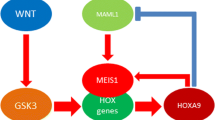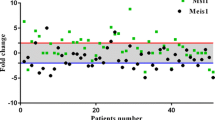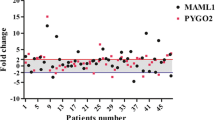Abstract
The homeobox transcription factor MEIS1 is involved in cell fate decision, stem cells properties, gastrointestinal (GI) tract development, and progression of several malignancies such as esophageal squamous cell carcinoma (ESCC). Increasing evidences suggest the crosstalk between MEIS1 and cell signaling pathways. Therefore, our aim in present study was to investigate the probable linkage of MEIS1 expression with key genes of different cell signaling pathways in ESCC tumorigenesis, and their correlation with clinicopathological feature of the patients. The gene expression profiling of MEIS1 and different cell signaling genes including SALL4, SIZN1, and HEY1 (stemness state, BMP, and NOTCH signaling pathways, respectively) was performed using quantitative real-time reverse transcription polymerase chain reaction (PCR) in fresh tumoral compared to margin normal tissues of 50 treatment-naive ESCC samples. The mRNA expression of MEIS1/SIZN1, SIZN1/HEY1, and SIZN1/SALL4 were significantly associated to each other (P < 0.05). There were remarkable correlations between concomitant mRNA expression of MEIS1 and SIZN1 in tumors with invasion to adventitia, early stages of tumor progression and poorly differentiated tumors. Moreover, expression of MEIS1 and HEY1 was correlated to each other in primary stages of tumor progression and non-invaded tumors. Expression of MEIS1 was significantly associated with SALL4 in poorly differentiated tumors. Our results indicated that correlation between different cell signaling pathway-related genes may lead to esophageal tumorigenesis. It is illustrated that MEIS1 as a HOX gene has a significant correlation with stemness state, BMP, and NOTCH signaling pathways via the SIZN1.



Similar content being viewed by others
References
Qi Y-J, Chao W-X, Chiu J-F (2012) An overview of esophageal squamous cell carcinoma proteomics. J Proteomics 75(11):3129–3137
Testa U, Castelli G, Pelosi E (2017) Esophageal cancer: genomic and molecular characterization, stem cell compartment and clonal evolution. Medicines 4(3):67
Qian J, Fang J-Y (2015) Genetic variations in esophageal cancer. Gastrointest Tumors 2(3):124–130
Yue Y et al (2017) Gene function analysis and underlying mechanism of esophagus cancer based on microarray gene expression profiling. Oncotarget 8(62):105222
Fu J-H et al (2015) RNA-sequencing based identification of crucial genes for esophageal squamous cell carcinoma. J Cancer Res Ther 11(2):420
Zhu J et al (2017) MEIS1 inhibits clear cell renal cell carcinoma cells proliferation and in vitro invasion or migration. BMC Cancer 17(1):176
Torres-Flores J and Jave-Suárez LF (2013) MEIS1 (Meis homeobox 1)
Aksoz M et al (2018) Emerging roles of Meis1 in cardiac regeneration, stem cells and cancer. Curr Drug Targets 19(2):181–190
Song F, Wang H, Wang Y (2017) Myeloid ecotropic viral integration site 1 inhibits cell proliferation, invasion or migration in human gastric cancer. Oncotarget 8(52):90050
Crist RC et al (2011) A conserved tissue-specific homeodomain-less isoform of MEIS1 is downregulated in colorectal cancer. PLoS ONE 6(8):e23665
Cillo C et al (2001) Homeobox genes in normal and malignant cells. J Cell Physiol 188(2):161–169
Seifert A et al (2015) Role of Hox genes in stem cell differentiation. World J Stem Cells 7(3):583
Mallak AJ et al (2016) Contribution of EVX1 in aggressiveness of esophageal squamous cell carcinoma. Pathol Oncol Res 22(2):341–347
Wang RN et al (2014) Bone morphogenetic protein (BMP) signaling in development and human diseases. Genes Dis 1(1):87–105
Singh A, Morris RJ (2010) The Yin and Yang of bone morphogenetic proteins in cancer. Cytokine Growth Factor Rev 21(4):299–313
Guo X, Wang X-F (2009) Signaling cross-talk between TGF-β/BMP and other pathways. Cell Res 19(1):71
Calvo MB et al (2009) Biology of BMP signalling and cancer. Clin Transl Oncol 11(3):126–137
Attisano L, Wrana JL (2000) Smads as transcriptional co-modulators. Curr Opin Cell Biol 12(2):235–243
Cho G, Lim Y, Golden JA (2009) SUMO interaction motifs in SIZN1 are required for PML-NB localization and for transcriptional activation. J Biol Chem 109:010181
Forghanifard MM, Abbaszadegan MR, Moghbeli M (2019) Role of SIZN1 in esophageal squamous cell carcinoma. Middle East J Cancer 10(1):37–42
Li H et al (2009) Human ZCCHC12 activates AP-1 and CREB signaling as a transcriptional co-activator. Acta Biochim Biophys Sin 41(7):535–544
Ionescu AM et al (2004) CREB Cooperates with BMP-stimulated Smad signaling to enhance transcription of the Smad6 promoter. J Cell Physiol 198(3):428–440
Xu R-H et al (1996) Involvement of Ras/Raf/AP-1 in BMP-4 signaling during Xenopus embryonic development. Proc Natl Acad Sci 93(2):834–838
Wang O et al (2017) ZCCHC12, a novel oncogene in papillary thyroid cancer. J Cancer Res Clin Oncol 143(9):1679–1686
Forghanifard MM et al (2014) Stemness state regulators SALL4 and SOX2 are involved in progression and invasiveness of esophageal squamous cell carcinoma. Med Oncol 31(4):922
Zhao W, Li Y, Zhang X (2017) Stemness-related markers in cancer. Cancer Transl Med 3(3):87
Yang J (2018) SALL4 as a transcriptional and epigenetic regulator in normal and leukemic hematopoiesis. Biomark Res 6(1):1
Yang L et al (2017) The stem cell factor SALL4 is an essential transcriptional regulator in mixed lineage leukemia-rearranged leukemogenesis. J Hematol Oncol 10(1):159
López-Mateo I et al (2016) HEY1 functions are regulated by its phosphorylation at Ser-68. Biosci Rep 36(3):e00343
Wöltje K, Jabs M, Fischer A (2015) Serum induces transcription of Hey1 and Hey2 genes by Alk1 but not Notch signaling in endothelial cells. PLoS ONE 10(3):e0120547
Yassin ER et al (2009) Dissection of the transformation of primary human hematopoietic cells by the oncogene NUP98-HOXA9. PLoS ONE 4(8):e6719
Villaronga M et al (2010) HEY1 Leu94Met gene polymorphism dramatically modifies its biological functions. Oncogene 29(3):411
Takizawa T et al (2003) Enhanced gene activation by Notch and BMP signaling cross-talk. Nucleic Acids Res 31(19):5723–5731
Gospodarowicz MK, Brierley JD, Wittekind C (2017) TNM classification of malignant tumours. Wiley, Hoboken
Harvey, A.J. (2019) Overview of cell signaling pathways in cancer. In: predictive biomarkers in oncology. Springer, New York, pp 167–182.
Kabir MH et al (2018) Identification of active signaling pathways by integrating gene expression and protein interaction data. BMC Syst Biol 12(9):120
Lambert M et al (2018) Targeting transcription factors for cancer treatment. Molecules 23(6):1479
Chen X et al (2018) Identification of key genes and pathways for esophageal squamous cell carcinoma by bioinformatics analysis. Exp Ther Med 16(2):1121–1130
Sanchez-Vega F et al (2018) Oncogenic signaling pathways in the cancer genome atlas. Cell 173(2):321–337
Fischbach NA et al (2005) HOXB6 overexpression in murine bone marrow immortalizes a myelomonocytic precursor in vitro and causes hematopoietic stem cell expansion and acute myeloid leukemia in vivo. Blood 105(4):1456–1466
Grier D et al (2005) The pathophysiology of HOX genes and their role in cancer. J Pathol 205(2):154–171
Abbaszadegan MR, Moghbeli M (2018) Role of MAML1 and MEIS1 in esophageal squamous cell carcinoma depth of invasion. Pathol Oncol Res 24(2):245–250
Moghbeli M et al (2016) Correlation between Meis1 and Msi1 in esophageal squamous cell carcinoma. J Gastrointest Cancer 47(3):273–277
Chen JL et al (2012) Deregulation of a Hox protein regulatory network spanning prostate cancer initiation and progression. Clin Cancer Res 18(16):4291–4302
Orlovsky K et al (2011) Down-regulation of homeobox genes MEIS1 and HOXA in MLL-rearranged acute leukemia impairs engraftment and reduces proliferation. Proc Natl Acad Sci 108(19):7956–7961
Owa T et al (2018) Meis1 coordinates cerebellar granule cell development by regulating Pax6 transcription, BMP signaling and Atoh1 degradation. J Neurosci 38(5):1277–1294
Dalcq J et al (2012) RUNX3, EGR1 and SOX9B form a regulatory cascade required to modulate BMP-signaling during cranial cartilage development in zebrafish. PLoS ONE 7(11):e50140
Erickson T, French CR, Waskiewicz AJ (2010) Meis1 specifies positional information in the retina and tectum to organize the zebrafish visual system. Neural Dev 5(1):22
Li Q-L et al (2012) ZCCHC12, a potential molecular marker of papillary thyroid carcinoma: a preliminary study. Med Oncol 29(3):1409–1417
Bhasin M et al (2005) Prediction of methylated CpGs in DNA sequences using a support vector machine. FEBS Lett 579(20):4302–4308
Rad A et al (2016) Predicting the molecular role of MEIS1 in esophageal squamous cell carcinoma. Tumor Biol 37(2):1715–1725
Mahmoudian RA et al (2019) MEIS1 knockdown may promote differentiation of esophageal squamous carcinoma cell line KYSE-30. Mol Genet Genomic Med 7:e746
Xie H et al (2018) MEIS-1 level in unresectable hepatocellular carcinoma can predict the post-treatment outcomes of radiofrequency ablation. Oncotarget 9(20):15252
He J et al (2016) Inhibition of SALL4 reduces tumorigenicity involving epithelial-mesenchymal transition via Wnt/β-catenin pathway in esophageal squamous cell carcinoma. J Exp Clin Cancer Res 35(1):98
Najafi M et al (2017) Crosstalk between SHH and stemness state signaling pathways in esophageal squamous cell carcinoma. J Cell Commun Signal 11(2):147–153
Miyazono K, Maeda S, Imamura T (2005) BMP receptor signaling: transcriptional targets, regulation of signals, and signaling cross-talk. Cytokine Growth Factor Rev 16(3):251–263
Wang Z et al (2010) GSK-3 promotes conditional association of CREB and its coactivators with MEIS1 to facilitate HOX-mediated transcription and oncogenesis. Cancer Cell 17(6):597–608
Assarnia S, Ardalan Khales S, Forghanifard MM (2019) Correlation between SALL4 stemness marker and bone morphogenetic protein signaling genes in esophageal squamous cell carcinoma. J Biochem Mol Toxicol 33(3):e22262
Forghanifard MM et al (2019) Role of DIDO1 in progression of esophageal squamous cell carcinoma. J Gastrointest Cancer 53:81
Braig S, Bosserhoff A (2013) Death inducer-obliterator 1 (Dido1) is a BMP target gene and promotes BMP-induced melanoma progression. Oncogene 32(7):837
Forghanifard MM et al (2013) Role of SALL4 in the progression and metastasis of colorectal cancer. J Biomed Sci 20(1):6
Zhang X et al (2015) SALL4: an emerging cancer biomarker and target. Cancer Lett 357(1):55–62
Rad A et al (2016) SOX1 is correlated to stemness state regulator SALL4 through progression and invasiveness of esophageal squamous cell carcinoma. Gene 594(2):171–175
Fukusumi T et al (2018) The NOTCH4–HEY1 pathway induces epithelial–mesenchymal transition in head and neck squamous cell carcinoma. Clin Cancer Res 24(3):619–633
Forghanifard MM, Taleb S, Abbaszadegan MR (2015) Notch signaling target genes are directly correlated to esophageal squamous cell carcinoma tumorigenesis. Pathol Oncol Res 21(2):463–467
Zavadil J et al (2004) Integration of TGF-β/Smad and Jagged1/Notch signalling in epithelial-to-mesenchymal transition. EMBO J 23(5):1155–1165
Fardi Golyan F, Abbaszadegan MR, Forghanifard MM (2019) TWIST1, MMP-21, and HLAG-1 co-overexpression is associated with ESCC aggressiveness. J Cell Biochem 120:14838
Acknowledgements
We gratefully acknowledge our colleagues at the Human Division of Human Genetics, Immunology Research Institute, Avicenna Research Institute (Mashhad University of Medical Sciences) for their scientific and technical supports.
Funding
No funding.
Author information
Authors and Affiliations
Corresponding author
Ethics declarations
Conflict of interest
The authors declare that they have no conflict of interest.
Ethical Approval
All procedures performed in studies involving human participants were in accordance with the ethical standards of the Human Ethics Committee of the Mashhad University of Medical Sciences (MUMS) (Mashhad, Iran) and with the 1964 Helsinki declaration and its later amendments or comparable ethical standards.
Informed Consent
Informed consent was obtained from all individual participants included in the study.
Additional information
Publisher's Note
Springer Nature remains neutral with regard to jurisdictional claims in published maps and institutional affiliations.
Rights and permissions
About this article
Cite this article
Mahmoudian, R.A., Forghanifard, M. Crosstalk between MEIS1 and markers of different cell signaling pathways in esophageal squamous cell carcinoma. Mol Biol Rep 47, 3439–3448 (2020). https://doi.org/10.1007/s11033-020-05423-5
Received:
Accepted:
Published:
Issue Date:
DOI: https://doi.org/10.1007/s11033-020-05423-5




